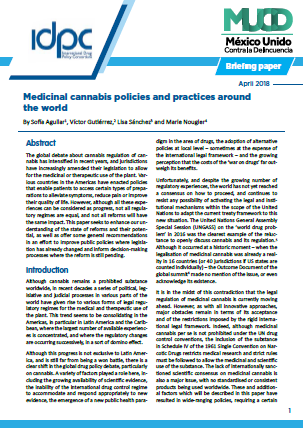Medicinal cannabis policies and practices around the world
April 2018
 Although cannabis remains a prohibited substance worldwide, in recent decades a series of political, legislative and judicial processes in various parts of the world have given rise to various forms of legal regulatory regimes for the medical and therapeutic use of the plant. This trend seems to be consolidating in the Americas, in particular in Latin America and the Caribbean, where the largest number of available experiences is concentrated, and where the regulatory changes are occurring successively, in a sort of domino effect.
Although cannabis remains a prohibited substance worldwide, in recent decades a series of political, legislative and judicial processes in various parts of the world have given rise to various forms of legal regulatory regimes for the medical and therapeutic use of the plant. This trend seems to be consolidating in the Americas, in particular in Latin America and the Caribbean, where the largest number of available experiences is concentrated, and where the regulatory changes are occurring successively, in a sort of domino effect.
![]()
Download the briefing (PDF)
Although this progress is not exclusive to Latin America, and is still far from being a won battle, there is a clear shift in the global drug policy debate, particularly on cannabis. A variety of factors played a role here, including the growing availability of scientific evidence, the inability of the international drug control regime to accommodate and respond appropriately to new evidence, the emergence of a new public health paradigm in the area of drugs, the adoption of alternative policies at local level – sometimes at the expense of the international legal framework – and the growing perception that the costs of the ‘war on drugs’ far outweigh its benefits.
Unfortunately, and despite the growing number of regulatory experiences, the world has not yet reached a consensus on how to proceed, and continues to resist any possibility of activating the legal and institutional mechanisms within the scope of the United Nations to adapt the current treaty framework to this new situation. The United Nations General Assembly Special Session (UNGASS) on the ‘world drug problem’ in 2016 was the clearest example of the reluctance to openly discuss cannabis and its regulation.5 Although it occurred at a historic moment – when the legalisation of medicinal cannabis was already a reality in 16 countries (or 40 jurisdictions if US states are counted individually) – the Outcome Document of the global summit6 made no mention of the issue, or even acknowledge its existence.
It is in the midst of this contradiction that the legal regulation of medicinal cannabis is currently moving ahead. However, as with all innovative approaches, major obstacles remain in terms of its acceptance and of the restrictions imposed by the rigid international legal framework. Indeed, although medicinal cannabis per se is not prohibited under the UN drug control conventions, the inclusion of the substance in Schedule IV of the 1961 Single Convention on Narcotic Drugs restricts medical research and strict rules must be followed to allow the medicinal and scientific use of the substance. The lack of internationally sanctioned scientific consensus on medicinal cannabis is also a major issue, with no standardised or consistent products being used worldwide. These and additional factors which will be described in this paper have resulted in wide-ranging policies, requiring a certain degree of compromise (when done at the sub-national level, for example), and governed by a diversity of norms and institutions. Inevitably, the scope and impact of these policies vary greatly.
As will be discussed below, all experiences are different, and no international or regional standards currently exist. While the regulation of medicinal cannabis in Uruguay resulted from government policy and coexists with licit recreational use in a clear effort to improve public health, in countries like Argentina, Brazil and Mexico, timid legislative reforms responded to citizen initiatives which, for lack of political support, only managed to open the minimum space necessary to comply with court orders and allow the importation of pharmacological preparations produced abroad. Meanwhile, North America is silently consolidating industrial-commercial models of regulation. Although not immune to political backlash and court decisions, Canada and the United States are now at the vanguard of scientific innovation, while also meeting clear revenue-collection goals, and providing a solid basis to expand recreational and industrial systems.
This report precisely highlights this diversity of experiences, approaches and directions. The purpose of this analysis is to enhance our understanding of the current state of reforms and the lessons to be learned from them. Although the authors have done their utmost to gather as much information as possible, this paper does not claim to be comprehensive review but rather a selection of key models of medicinal cannabis being developed around the world as of March 2018. Based on the findings, we offer general recommendations, in an effort to improve public policies in areas where legislation has already changed, and inform decision-making processes in countries where reform is still pending.







